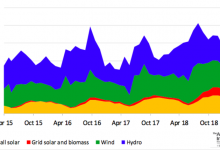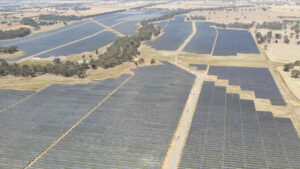The renewable energy share of Australia’s electricity generation has risen to 21.2 per cent, as wind and solar – both large scale and rooftop installations – continue to eat into the pie previously reserved for coal and gas.
The latest data from the National Energy Emissions Audit – published by The Australia Institute – also point to a decline in overall gas use by industry and households, due to its high price.
But while emissions from the electricity grid fell thanks to more wind and solar, emissions in the transport sector continued to jump, and Australia’s fuel security remained precarious with the lack of any policy, coherent or otherwise, on fuel emissions or electric vehicles.
The audit notes that Australia over the last three years has experienced no systematic or sustained change in total demand in the National Electricity Market, largely a result of the continued investment in rooftop solar, and the results of the few energy efficiency programs.
That means that as the installations of rooftop solar and large scale renewables grows, the output of fossil fuels reduces – initially this hit brown coal, but more recently it has impacted gas generation because of its high cost.
 The audit says that rooftop solar continues to climb and is now generating about 7.5 TWh per year, equivalent to more than 4 per cent of the total electricity used.
The audit says that rooftop solar continues to climb and is now generating about 7.5 TWh per year, equivalent to more than 4 per cent of the total electricity used.
 Including large scale wind and solar, which have both grown rapidly in the last few years as developers and retailers scrambled to meet the renewable energy target, and then committed to more because of its low costs, the total share of renewables stands at 21.2 per cent in the last 12 months.
Including large scale wind and solar, which have both grown rapidly in the last few years as developers and retailers scrambled to meet the renewable energy target, and then committed to more because of its low costs, the total share of renewables stands at 21.2 per cent in the last 12 months.
It is growing, because of the sheer scale of capacity still in the pipeline, but the growth in output has recently slowed because of network constraints changes and changes to marginal loss factors.
 The increase in renewables has helped accelerate a reductions in electricity emissions, but the story elsewhere is less good. And the biggest concern is the growth in petroleum emissions (red line in graph above), mostly from land transport amid a complete vacuum in national policy leadership on vehicles.
The increase in renewables has helped accelerate a reductions in electricity emissions, but the story elsewhere is less good. And the biggest concern is the growth in petroleum emissions (red line in graph above), mostly from land transport amid a complete vacuum in national policy leadership on vehicles.
“As we have repeatedly noted, unless and until Australia has a set of genuine policies directed at decisively changing the trend of transport energy consumption, transport related emissions will continue their inexorable growth,” report author Hugh Saddler writes.
“Continuing growth in use of petroleum fuels for transport also presents supply security challenges.
“In 2017-18, imported crude oil and petroleum products supplied 97 per cent of Australia’s total consumption of petroleum products, expressed in terms of simple volumes.
“When account is taken of exports from Australia, dependence on imports falls to 71 per cent in net terms.
“However, about half of the exports are condensate (very light hydrocarbons), which cannot be used to any significant extent by Australian oil refineries to produce transport fuels. It follows that Australia’s petroleum import dependence is well over 80% in “true” net terms.”










